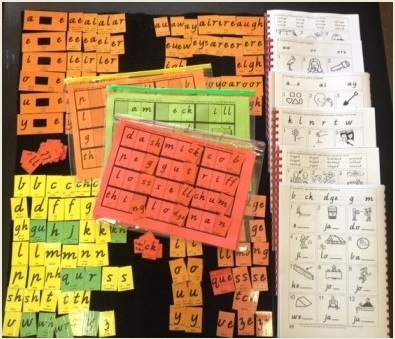Victorian Modern Cursive
0 Replies
Victorian Modern Cursive script is the handwriting style taught in my local schools, in Victoria, Australia, and I understand it's also used in Western Australian and Northern Territory schools.
There aren't a lot of teaching resources published in Victorian Modern Cursive script, so if your learners are using it, you might be interested in the Victorian Modern Cursive versions of my synthetic phonics materials.
There are currently eight workbooks, 14 games and a moveable alphabet available, and I'm working on more in my copious spare time, ehem.
Victorian Modern Cursive workbooks
The workbooks progress in tiny steps and teach how to build hundreds of words using all the major letters/spellings used in one-syllable words, covering concepts like beginning v/s ending spellings, grammatical forms like plural and past tense, doubling of letters, a little bit of punctuation (possessives, contractions), vowel spelling variations, homographs, homophones and sounds that share a spelling (e.g. sea, head, great).
You can see video tours of the entire contents of each workbook on YouTube – click on the links below for the level or levels of interest to you:
The workbooks in the videos are in the Comic Sans font in which I originally wrote them, for use with my older, catch-up learners in speech therapy. Many of them are unhappy about using materials that look like "little kids stuff" so Victorian Modern Cursive script would not be appropriate.
But then along came some of my favourite primary school teachers and said "can you make a version in Victorian Modern Cursive?" And who can say no to enthusiastic primary teachers? Not me. You can briefly see the Victorian Modern Cursive versions towards the end of each video, and they are clearly marked and easily located in this site's shop.
These materials are all sold as downloadable pdfs, and are intended to be affordable for schools and parents, and easy to store, print, and display on those fancy electronic whiteboards everyone seems to have these days, plus replace if they get ripped or the dog eats them.
Victorian Modern Cursive games
The games are all race-to-build words games, a bit like bingo, which you print out on coloured paper and laminate, then cut up two of the pages (or get a youngster keen to help and with sharp scissor skills to do it). I've had parents tell me their children enjoyed them so much they had to be told to stop playing. There exists is no greater happiness for a game-maker-upper than to hear that.
Letter/spelling combinations have been chosen very carefully to maximise the number of potential real words that can be built. Arguments about whether to accept people's names, and words like "sim" as in "Sim card", are all part of these games.
The first game requires learners to complete words by adding first sounds, in the second one you have to add the last sounds, and you add middle (vowel) sounds in the third game. I have some more games like these in my head, but just haven't found time to put them on paper yet.
Click here to see video demonstrations of these games on YouTube.
Victorian Modern Cursive moveable alphabet
My moveable alphabet contains what I like to call the 100 first spellings of English. After all, why teach the first 100 words, when you could teach the first 100 spellings, and then be able to build thousands and thousands of words?
Like most moveable alphabets, this one is best used to build and change one-syllable words – if you try to make longer words you keep running out of particular letters and not being able to find the letter you want.
So build a word and then change one part of it to make a new word, e.g. build fat, change it to flat, change it to flag, change it to flan, change it to fan, change it to fin, change it to fun etc. This strengthens learners' ability to hear the identity, order and number of sounds in words (phonemic awareness) as well as their spelling pattern knowledge.
This moveable alphabet is colour-coded like a traffic light. Green means go, for beginning spellings; orange means caution, for vowel spellings, which can be very tricky; red means stop, for ending spellings. Yellow spellings can go either before or after a vowel.
You can see some of the pieces of my moveable alphabet in this video giving a conceptual overview of our spelling system. The alphabet in the video is again not the Victorian Modern Cursive one, but both are in this website's shop, and the only difference between them is the font.
Example words for each spelling
My moveable alphabet is highly explicit about sound-letter relationships, because each piece includes little words that give an example of the main sounds represented by that spelling. For example, the spelling "er" has the words "her", "zero" and "clerk" written on it in small letters.
This is as much for teachers/parents as it is for learners, so that when you come to an unusual spelling, you don't get too worried – it's not a mistake or oversimplification, it's part of the system, just not the most common pattern, or the pattern we are learning now.
The moveable alphabet is also a pdf you print out and laminate, and thanks to the wonders of magnetic tape (a single roll is enough, about $8 in stationery shops) it's a cinch to turn into fridge/whiteboard magnets, or you can use adhesive hook velcro (from fabric or stationery stores) to attach it to a velcro-compatible fabric noticeboard. Print it at 200% if you need a bigger version.



Leave a Reply